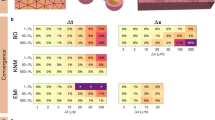Abstract
We derive the values for the intracellular and extracellular conductivities needed for bidomain simulations of cardiac electrophysiology using homogenization of partial differential equations. In our model, cardiac myocytes are rectangular prisms and gap junctions appear in a distributed manner as flux boundary conditions for Laplace’s equation. Using directly measurable microproperties such as cellular dimensions and end-to-end and side-to-side gap junction coupling strengths, we inexpensively obtain effective conductivities close to those given by simulations with a detailed cyto-architecture (Stinstra et al. in Ann. Biomed. Eng. 33:1743–1751, 2005). This model provides a convenient framework for studying the effect on conductivities of aligned vs. brick-like arrangements of cells and the effect of different distributions of gap junctions along the myocyte membranes.
Similar content being viewed by others
References
Camelliti, P., Green, C., Kohl, P., 2006. Structural and functional coupling of cardiac myocytes and fibroblasts. In: Dhein, S. (Ed.), Cardiovascular Gap Junctions, Adv. Cardiol., vol. 42, pp. 132–149. Karger, Basel.
Clerc, L., 1976. Directional differences of impulse spread in trabecular muscle from mammalian heart. J. Physiol. 255, 335–346.
Fishman, G., 2008. Personal communication.
Henriquez, C., 1993. Simulating the electrical behavior of cardiac tissue using the bidomain model. Crit. Rev. Biomed. Eng. 21, 1–77.
Hubbard, M., Ying, W., Henriquez, C., 2007. Effect of gap junction distribution on impulse propagation in a monolayer of myocytes: a model study. Europace 9, vi20–vi28.
Keener, J., 1996. Direct activation and defibrillation of cardiac tissue. J. Theor. Biol. 178, 313–324.
Keener, J., Sneyd, J., 1998. Mathematical Physiology. Springer, Berlin.
Kléber, A., Riegger, C., 1987. Electrical constants of arterially perfused rabbit papillary muscle. J. Physiol. 385, 307–324.
Kohl, P., Camelliti, P., Vurton, F., Smith, G., 2005. Electrical coupling of fibroblasts and myocytes: relevance for cardiac propagation. J. Electrocardiol. 38, 45–50.
Krassowska, W., Pilkington, T., Ideker, R., 1990. Potential distribution in three-dimensional periodic myocardium—Part I: solution with two-scale asymptotic analysis. IEEE Trans. Biomed. Eng. 37(3), 252–266.
Mori, Y., Fishman, G., Peskin, C., 2008. Ephaptic conduction in a cardiac strand model with 3D eletrodiffusion. Proc. Natl. Acad. Sci. 105, 6463–6468.
Neu, J., Krassowska, W., 1993. Homogenization of syncytial tissues. Crit. Rev. Biomed. Eng. 21, 137–199.
Panfilov, A., Keldermann, R., Nash, M., 2007. Drift and breakup of spiral waves in reaction–diffusion-mechanics systems. Proc. Natl. Acad. Sci. 104, 7922–7926.
Roberts, D., Scher, A., 1982. Effect of tissue anisotropy on extracellular potential fields in canine myocardium in situ. Circ. Res. 50, 342–351.
Roberts, D., Hersh, L., Scher, A., 1979. Influence of cardiac fiber orientation on wavefront voltage, conduction velocity, and tissue resistivity in the dog. Circ. Res. 44, 701–712.
Shaw, R., Rudy, Y., 1997. Ionic mechanisms of propagation in cardiac tissue—roles of the sodium and L-type calcium currents during reduced excitability and decreased gap junction coupling. Circ. Res. 81, 727–741.
Stinstra, J., Hopenfeld, B., Macleod, R., 2005. On the passive cardiac conductivity. Ann. Biomed. Eng. 33, 1743–1751.
Weidmann, S., 1970. Electrical constants of trabecular muscle from mammalian heart. J. Physiol. 210, 1041–1054.
Yao, J., Gutstein, D., Liu, F., Fishman, G., Wit, A., 2003. Cell coupling between ventricular myocyte pairs from connexin43-deficient murine hearts. Circ. Res. 93, 736–743.
Author information
Authors and Affiliations
Corresponding author
Rights and permissions
About this article
Cite this article
Hand, P.E., Griffith, B.E. & Peskin, C.S. Deriving Macroscopic Myocardial Conductivities by Homogenization of Microscopic Models. Bull. Math. Biol. 71, 1707–1726 (2009). https://doi.org/10.1007/s11538-009-9421-y
Received:
Accepted:
Published:
Issue Date:
DOI: https://doi.org/10.1007/s11538-009-9421-y




